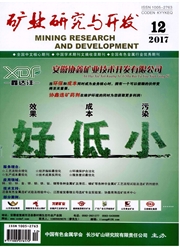

 中文摘要:
中文摘要:
为了掌握不同煤自燃特性参数对采空区"三带"分布的影响,利用煤氧化模拟实验系统对开滦集团钱家营矿、唐山矿、荆各庄矿9^#、荆各庄矿11^#四个煤样进行了绝热氧化实验。基于实验数据,对各煤样不同温度下的耗氧速率和放热强度进行了计算,并利用Fluent软件模拟不同煤自燃特性参数条件下采空区"三带"分布情况。结果表明,氧化带宽度最大的是唐山煤样80.3m,最小的是钱家营矿煤样24.2m。结合理论分析得出,耗氧速率越大,采空区"氧化带"的宽度越大,而放热强度大,一定程度上使"氧化带"范围增大。同时结合各煤样的最小自然发火期确定了相应煤层的最小推进速度,对于防治采空区自然发火具有重要作用。
 英文摘要:
英文摘要:
In order to master "three zone" distribution rule of goaf under different coal spontaneous combustion properties, by coal oxidation simulation system, the adiabatic oxidation experiments were carried out on four coal samples from Qianjiaying mine, Tangshan mine, 9^# and 11^# areas of Jinggezhuang mine. Based on experimental results, the oxygen consumption rate and heat emitting intensity of coal samples at different temperatures were calculated and the " three zones" distribution under different coal spontaneous combustion parameters was simulated with Fluent software. The simulation results showed that the largest oxidation zone was Tangshan samples at the width of 80.3 m. and the smallest was Qianjiaying samples at the width of 24.2 m. Combining with theoretical analysis, it concluded that the greater of oxygen consumption rate, the wider of oxidation zone and the greater of heat emitting intensity, to some extent the larger of oxidation zone scope. Furthermore, according to the shortest coal spontaneous combustion time, the minimum advancing speed of working face was determined, which played an important role for preventing goal spontaneous combustion.
 同期刊论文项目
同期刊论文项目
 同项目期刊论文
同项目期刊论文
 Numerical investigation and theoretical prediction of self-ignition characteristics of coarse coal s
Numerical investigation and theoretical prediction of self-ignition characteristics of coarse coal s Experimental study on mechanism of hydroxyl variation and the critical temperatures in the process o
Experimental study on mechanism of hydroxyl variation and the critical temperatures in the process o 期刊信息
期刊信息
